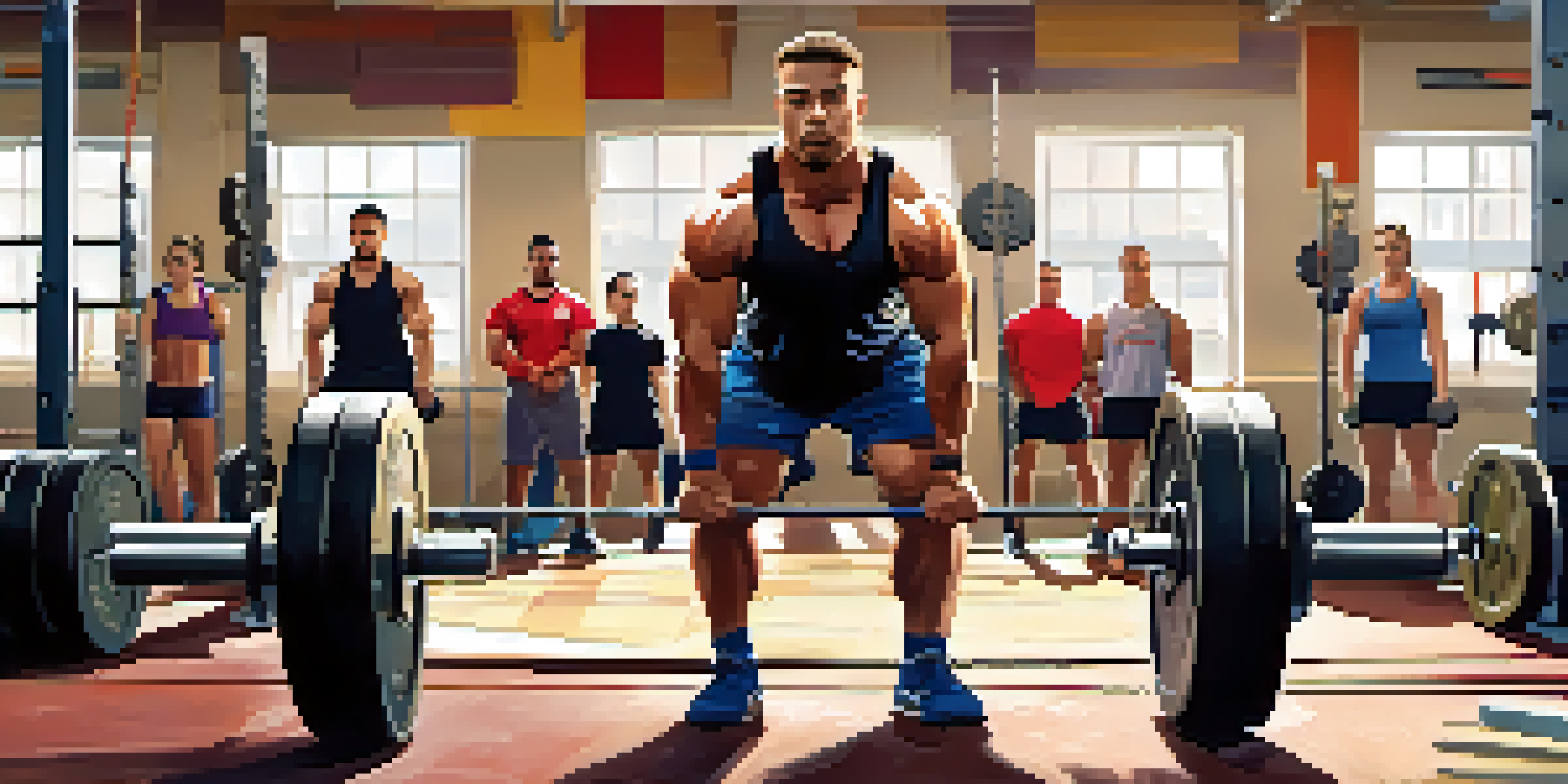The Role of Weight Classes in Powerlifting Success

What Are Weight Classes in Powerlifting?
Weight classes in powerlifting are categories that group competitors based on their body weight. This system ensures that lifters compete against others of similar size, which levels the playing field. For instance, a lifter in the 74 kg class won't face someone weighing 120 kg, allowing for fairer competition.
Strength is not just about lifting heavy weights; it's about knowing your body and how to optimize it for success.
These classes help to promote safety and integrity in the sport. When lifters compete against those of similar body mass, it reduces the likelihood of injury and enhances the competitive experience. Without these classes, the disparity in strength and size could lead to imbalanced outcomes.
The International Powerlifting Federation (IPF) and other organizations have established specific weight classes, making it easier for athletes to understand where they fit. This structure not only helps in competition but also encourages athletes to set realistic goals based on their weight category.
The Importance of Choosing the Right Weight Class
Selecting the correct weight class is crucial for any powerlifter aiming for success. Lifters must balance their body weight with their strength levels to maximize their competitive edge. For example, a lifter who is too light may struggle against heavier opponents, while one who is too heavy may miss weight limits or lose strength efficiency.

Athletes often undergo a process of trial and error to determine which weight class suits them best. This involves monitoring their training, nutrition, and overall performance. The right choice can lead to better lifts and a more fulfilling competitive experience.
Weight Classes Ensure Fairness
Weight classes in powerlifting group competitors by body weight, creating a level playing field that promotes safety and integrity.
Ultimately, the goal is to find a weight class where the lifter can showcase their strengths while minimizing the disadvantages posed by size differences. This careful selection can be the difference between winning and merely participating.
How Weight Classes Affect Training Regimens
Weight classes directly influence how powerlifters structure their training programs. For instance, a lifter aiming to compete in a lower weight class might focus on fat loss while maintaining strength. This can lead to specific dietary strategies and workout routines designed to shed weight without sacrificing performance.
Success in powerlifting comes not only from physical strength but also from mental resilience and strategic planning.
Conversely, a lifter in a higher weight class may prioritize muscle gain and strength training. Their regimen might include heavier lifting and more caloric intake to increase body mass efficiently. Each approach requires careful planning and consistency to ensure success on the platform.
Moreover, understanding the dynamics of their weight class helps lifters adjust their training intensity and volume. A well-tailored training plan considering weight class can lead to significant improvements in competition readiness and overall performance.
Psychological Factors in Weight Class Selection
The choice of weight class isn't just a physical decision; it also has psychological implications. Athletes often experience pressure, both from themselves and external sources, regarding their appearance and performance. This can lead to anxiety over making weight or concerns about being at a disadvantage.
Many lifters find that they perform better when they are mentally comfortable in their weight class. This comfort can come from self-acceptance and understanding their strengths, which allows them to focus on performance rather than worry about weight. A positive mindset can enhance overall lifting ability.
Choosing the Right Class Matters
Selecting the appropriate weight class is vital for powerlifters to balance body weight and strength for optimal performance.
Building a supportive community and seeking guidance from coaches can also help alleviate these pressures. Being part of a team that understands the nuances of weight class dynamics can foster a more positive competitive experience.
Nutrition Strategies for Different Weight Classes
Nutrition plays a critical role in determining how effectively athletes can compete in their chosen weight classes. For those looking to shed pounds, calorie deficits, and macronutrient manipulation become essential strategies. This might include higher protein intake to preserve muscle while losing fat.
On the other hand, lifters aiming to gain weight must focus on consuming more calories than they burn. This requires a well-planned diet rich in nutrients to ensure they build strength without compromising their health. Foods high in protein, healthy fats, and complex carbohydrates are often staples in their diets.
Regardless of the goal, maintaining hydration and micronutrient intake is crucial for all powerlifters. Proper nutrition not only supports competition readiness but also contributes to overall health and well-being, creating a sustainable path for success.
The Competitive Edge: Weight Class Records
Each weight class in powerlifting has its own set of records, which can serve as a motivating factor for lifters. Setting or breaking records within a specific class can elevate an athlete's status and provide a sense of accomplishment. It's a tangible goal that can drive training and focus.
Athletes often study existing records in their weight class to understand the benchmarks they need to surpass. This knowledge can inform their training strategies and help them set realistic goals. Knowing what others have achieved can also inspire lifters to push their limits.
Nutrition Drives Competitive Success
Effective nutrition strategies tailored to specific weight classes are essential for athletes to achieve their goals, whether it's losing or gaining weight.
As they work towards these records, lifters often find themselves in a community of competitors who share similar aspirations. This camaraderie can foster a healthy competitive spirit that benefits everyone involved, pushing each lifter to reach new heights.
Future Trends in Weight Classes and Powerlifting
As powerlifting continues to evolve, so too does the conversation around weight classes. There's ongoing debate about the potential for new weight categories or adjustments to existing ones, reflecting changes in athlete demographics and body types. These adaptations can make the sport more inclusive and accessible.
Technology and data analytics are also playing a role in how weight classes are perceived and utilized. By analyzing performance metrics across different weight classes, athletes and coaches can identify trends and adjust training programs accordingly. This data-driven approach can enhance competitive strategies.

Lastly, as awareness of health and wellness grows, there may be a shift toward more sustainable weight management practices. This could lead to a focus on overall athlete well-being rather than merely conforming to weight class standards, fostering a healthier future for powerlifting.